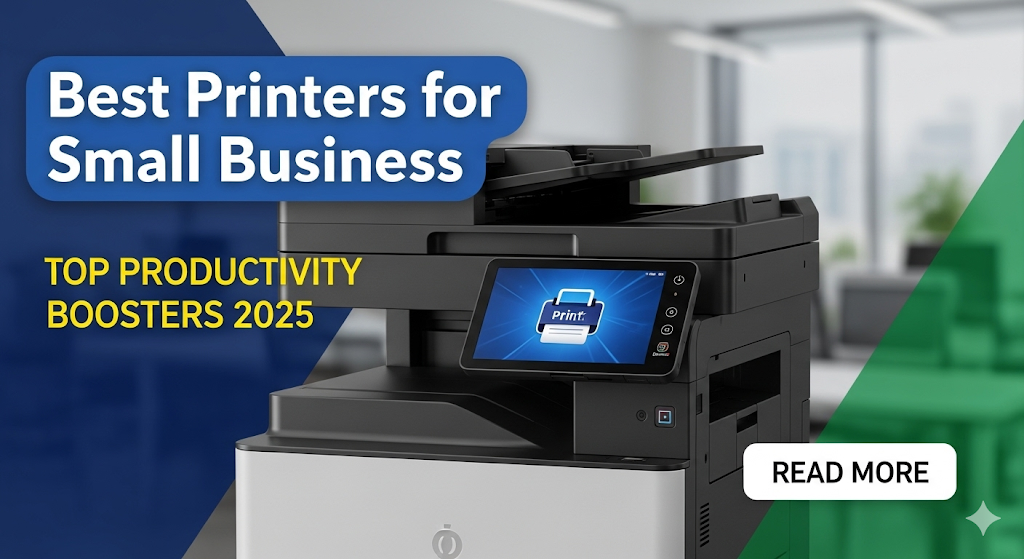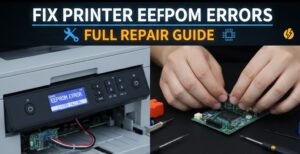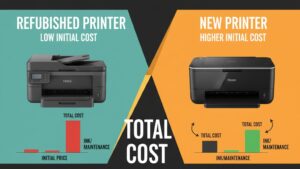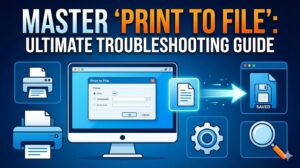Introduction
The best printers for small business operations can transform your workplace efficiency while keeping costs under tight control. Small businesses face unique printing challenges that require smart equipment choices to maximize productivity and minimize expenses.
Unlike large corporations with dedicated IT departments, small businesses need printers that work reliably with minimal maintenance. You need equipment that handles diverse tasks from professional client proposals to internal memos without breaking your budget.
The right printer choice impacts everything from daily workflow efficiency to professional image presentation. Poor printer selection leads to costly downtime, frustrated employees, and missed business opportunities.
This comprehensive guide reveals proven strategies for selecting printers that boost small business productivity while delivering exceptional value for your investment.
What Are Small Business Productivity Printers?
Small business productivity printers are versatile devices designed specifically for growing companies with 5-50 employees. These printers balance professional capabilities with budget-friendly operation costs.
Unlike basic home printers, productivity-focused models offer faster print speeds, higher monthly duty cycles, and robust connectivity options. They handle everything from simple text documents to complex marketing materials with consistent quality.
The best printers for small business environments typically feature multifunction capabilities including printing, scanning, copying, and faxing. This consolidation saves valuable office space while reducing equipment costs and maintenance complexity.
Modern small business printers also prioritize wireless connectivity and mobile printing support. These features enable flexible work arrangements and seamless integration with smartphones, tablets, and laptops used by today’s mobile workforce.
Energy efficiency and compact designs make these printers ideal for smaller office spaces where every square foot matters for operational efficiency and employee comfort.
6 Smart Strategies to Choose Perfect Small Business Printers
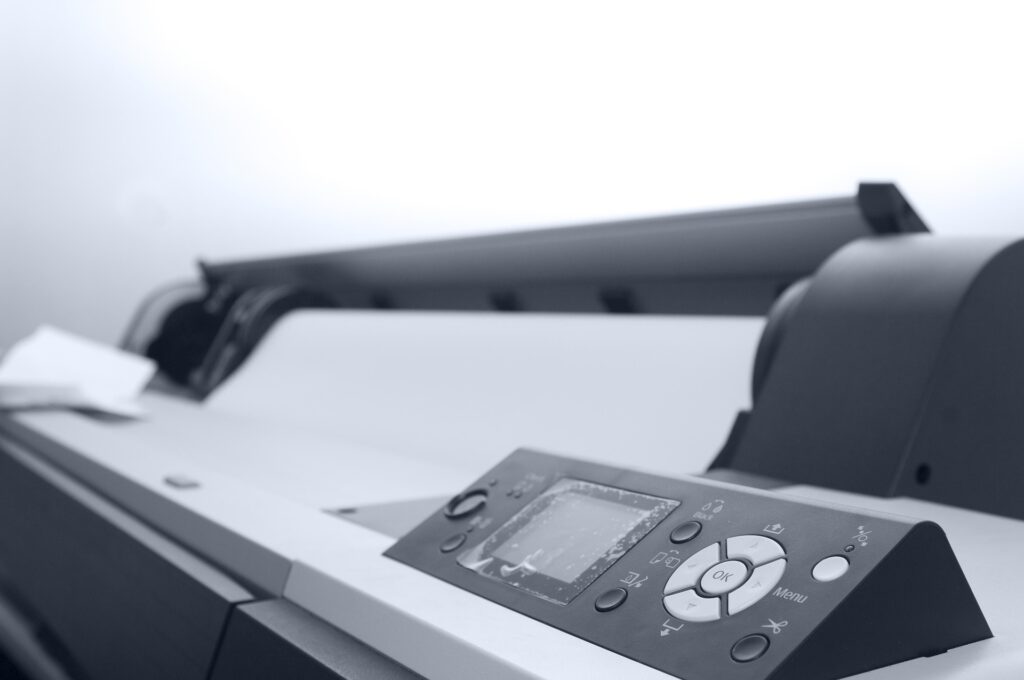
Strategy 1: Assess Your Monthly Print Volume
Calculate your actual printing needs by tracking usage for 2-3 months. Include all document types from invoices and contracts to marketing flyers and employee handbooks.
Small businesses typically print 500-3,000 pages monthly. The best printers for small business environments should handle 150% of your current peak volume to accommodate growth and busy periods.
Don’t forget to count color printing separately. Color pages cost significantly more than black-and-white, so accurate estimates help you choose between monochrome and color models effectively.
Strategy 2: Determine Essential Features
List must-have features based on your daily operations. Most small businesses benefit from automatic duplex printing, wireless connectivity, and mobile printing capabilities.
Consider whether you need scanning and copying functions. All-in-one models cost more upfront but save money compared to buying separate devices for each function.
Security features matter even for small businesses. Look for user authentication, encrypted printing, and secure wireless connections to protect sensitive client and financial information.

Strategy 3: Calculate Total Ownership Costs
Look beyond purchase price to understand true operating expenses. Include toner or ink costs, maintenance, energy consumption, and potential repair expenses over 3-5 years.
Laser printers typically offer lower per-page costs for high-volume printing, while inkjet models work better for occasional color printing and photo reproduction needs.
Factor in supply availability and costs. Popular printer brands often have more affordable third-party supplies available, reducing long-term operational expenses significantly.
Strategy 4: Evaluate Space and Design Requirements
Measure available space carefully before selecting printer size. Compact desktop models save space but may lack features or capacity needed for growing businesses.
Consider paper capacity requirements. Models with 250+ sheet input trays reduce refill frequency, improving productivity during busy periods when staff time is precious.
Think about noise levels if the printer will operate near workstations. Laser printers tend to be louder than inkjet models during operation, which might disrupt small office environments.
Strategy 5: Research Brand Reliability and Support
Choose established brands with strong reputations for reliability and customer service. Small businesses cannot afford extended downtime waiting for repairs or replacement parts.
Read user reviews from other small business owners to understand real-world performance and common issues. Pay attention to comments about long-term reliability and support quality.
Verify local service availability and response times. Some manufacturers offer next-business-day replacement for critical business equipment, which can prevent costly productivity losses.
Strategy 6: Plan for Future Growth
Select printers that can grow with your business needs. Models with expandable memory, additional paper trays, and higher duty cycles provide room for expansion.
Consider network scalability if you plan to add employees or locations. Enterprise-grade security and management features become important as your business grows and handles more sensitive information.
Think about integration with future software systems. Cloud connectivity and mobile printing capabilities ensure your printer investment remains valuable as technology evolves.

Advanced Tools and Professional Insights
Print management software helps small businesses track usage, control costs, and optimize printer performance. These tools provide detailed reports showing which departments or projects consume the most printing resources.
Cloud-based printing solutions enable remote work flexibility while maintaining security. Employees can print from anywhere while administrators maintain control over access and usage policies.
Managed print services make sense for small businesses wanting predictable monthly costs. These programs include supplies, maintenance, and support for fixed monthly fees based on usage.
Consider subscription ink or toner programs that automatically deliver supplies before you run out. These services often offer discounted rates and eliminate emergency supply runs during critical projects.
Environmental impact matters for businesses focused on sustainability. Energy Star certified printers and recycling programs demonstrate corporate responsibility while reducing operational costs.
Common Mistakes and Smart Solutions
The biggest mistake small businesses make is choosing the cheapest printer without considering operational costs. The best printers for small business success balance upfront investment with long-term value.
Underestimating print volume leads to frequent cartridge changes and potential equipment failure. Always plan for business growth and seasonal fluctuations when sizing printer capacity.
Ignoring connectivity requirements creates workflow bottlenecks. Ensure your chosen printer supports all devices and operating systems used in your office environment.
Poor placement decisions affect both performance and user satisfaction. Position printers in central locations with adequate ventilation and easy access for supplies and maintenance.
Skipping regular maintenance reduces reliability and print quality. Establish cleaning schedules and follow manufacturer recommendations to prevent costly repairs and replacements.
Inadequate staff training wastes money on supplies and reduces productivity. Invest time in teaching employees proper operation procedures and basic troubleshooting techniques.
Failing to secure printer networks exposes businesses to cyber threats. Configure strong passwords, enable encryption, and regularly update firmware to protect sensitive information.
Frequently Asked Questions
Q: What’s the ideal print speed for small businesses? A: Most small businesses benefit from printers capable of 20-35 pages per minute. This speed handles daily tasks efficiently without paying premium prices for unnecessary speed.
Q: Should small businesses choose laser or inkjet printers? A: Laser printers work better for high-volume text documents with lower per-page costs. Inkjet printers excel at color graphics and photos but cost more per page for text printing.
Q: How important are multifunction features for small businesses? A: Very important. All-in-one printers save money, space, and simplify maintenance compared to separate devices. Most small businesses benefit from combined printing, scanning, and copying capabilities.
Q: What security features do small business printers need? A: Essential features include user authentication, encrypted data transmission, secure print release, and regular firmware updates to protect client information and business documents.
Q: How do I calculate the right monthly duty cycle? A: Choose printers with duty cycles at least 3x your monthly volume. This ensures reliable operation and extends equipment life even during busy periods or business growth.
Conclusion
Selecting the best printers for small business success requires balancing current needs with future growth plans. The six strategies outlined here ensure you evaluate all critical factors before making this important investment.
Remember that total cost of ownership matters more than initial purchase price. Factor in supplies, maintenance, energy consumption, and potential downtime costs when comparing options.
The right printer choice supports your team’s productivity and professional image while controlling operational expenses. Take time to assess your specific requirements and choose equipment that grows with your business.
Smart printer selection becomes a competitive advantage that frees your team to focus on core business activities rather than equipment problems and workflow bottlenecks.
Best Printer for Busy Office: Ultimate Selection Guide 2025 Read More.

